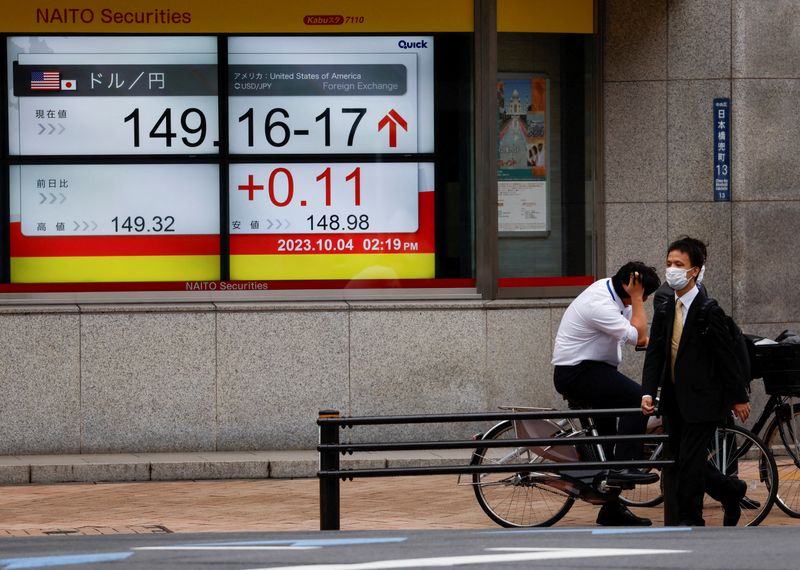Asia stocks see slim weekly gain, await US inflation
2023.12.21 21:40

© Reuters. Passersby walk past an electric monitor displaying the Japanese yen exchange rate against the U.S. dollar outside a brokerage in Tokyo, Japan October 4, 2023. REUTERS/Issei Kato/file photo
By Tom Westbrook
SINGAPORE (Reuters) – Asian stocks were poised to eke out gains for the final full trading week of the year on Friday, while the dollar eyed a loss as investors look to 2024 as a year of steep U.S. rate cuts.
MSCI’s broadest index of Asia-Pacific shares outside Japan went up 0.3% in early trade. For the week the index is very marginally higher. Banking shares helped rise 0.2%. The euro poked above $1.10.
Markets have been in a festive mood for weeks as inflation data around the world has showed a slowdown and the Federal Reserve signalled it was done raising interest rates.
Two-year U.S. Treasury yields are down almost 38 basis points in a week and a half and fell 2 bps overnight when third-quarter U.S. core PCE inflation was revised down to 2%.
The data has markets girding for a downside surprise on the last key number before Christmas, November’s personal consumption expenditure index, due at 1330 GMT with consensus expectations for a monthly increase of 0.2%.
“Analysts are confident it shouldn’t be higher than 0.2%,” said National Australia Bank (OTC:)’s head of currency strategy Ray Attrill in Sydney.
“Could we get 0.1%? It’d probably take a 0.1% to see and extension of the moves we have seen.”
Overnight U.S. stocks bounced back from a sudden slide at the end of Wednesday’s session and the rose 1%.
The index is within 2% of its record high.
were steady in Asia, though Nike (NYSE:) shares slid almost 12% in after-hours trade after the company cut its sales forecast, blaming cautious consumers.
European futures rose 0.1%.
Oil is set for a weekly gain on nervousness about the security of Red Sea shipping, but prices fell overnight after Angola said it would quit OPEC, raising questions about the producer group’s efforts to limit global supply. [O/R]
futures were up 12 cents to $79.49 a barrel in Asia trade on Friday, for a weekly gain of 3.8%.
TALE OF TWO HAVENS
In currency trade the dollar has come under pressure from markets’ expectation of more than 150 bps of rate cuts in 2024.
At $1.1002 the euro is up 1% this week, even though a similar amount of cuts are priced in for Europe next year. The common currency is also up about 1% against sterling, which fell sharply this week after a surprise dive in inflation.
Sterling was set for its biggest weekly drop on the euro and against the dollar for three months. It last bought $1.2686 and traded at 86.71 pence per euro.
The is down 0.8% this week to 101.81. For the year it is down 2.4%. Among G10 currencies the best performer of the year was the Swiss franc, up nearly 8% on the dollar, while the yen’s 7.8% drop made it the worst.
NAB’s Attrill noted the mirror moves of the two so-called “safe haven” currencies underscored the overwhelming influence of the Bank of Japan’s (BOJ) monetary policy. It has stuck with negative interest rates while the rest of the world has hiked.
Policymakers debated communication around an eventual exit from such settings in December, meeting minutes showed on Friday. But data showing a slowdown in the pace of Japan’s core inflation takes off some of the pressure to hurry.
Hong Kong stocks rose 0.4% on Friday. Gold is set to end the week and the year ahead, with a 12% gain so far this year to $2,049 an ounce.
is up 160% this year to $44,161.








